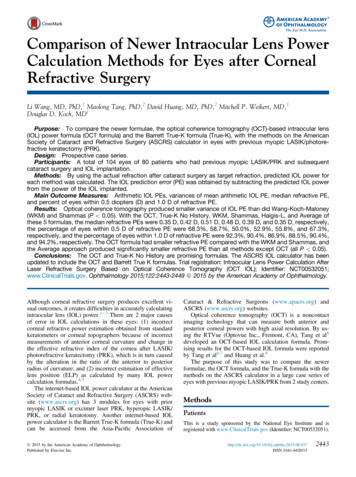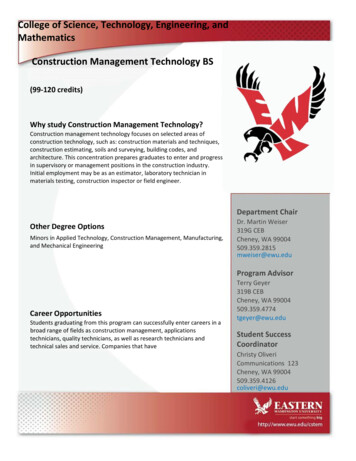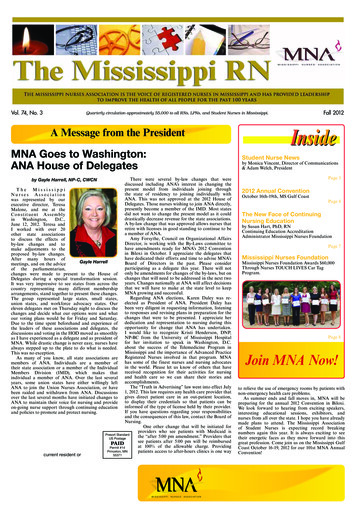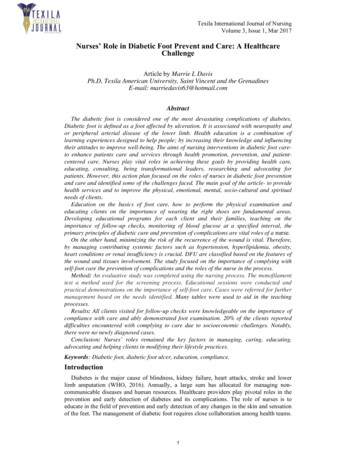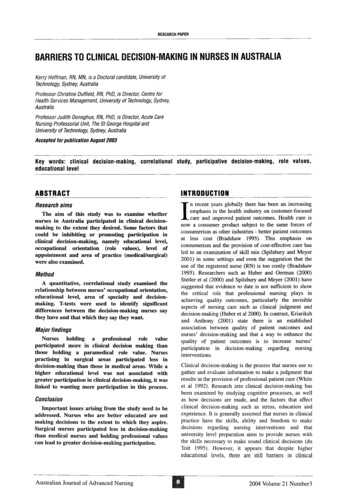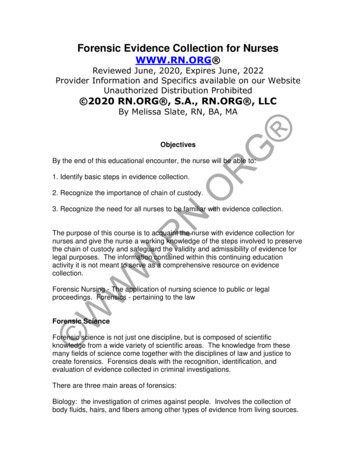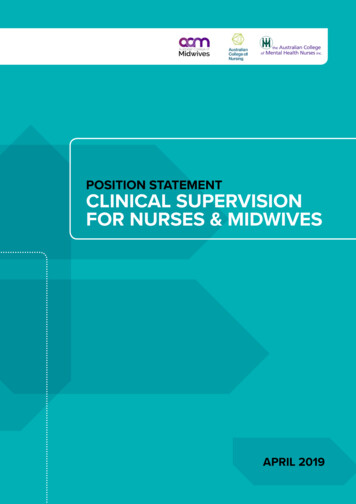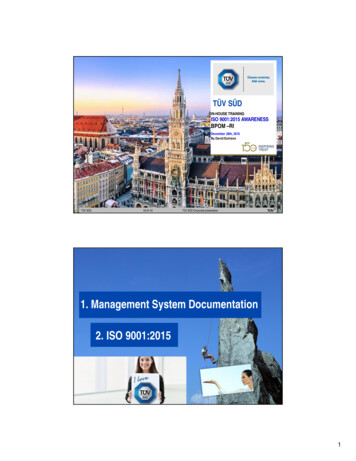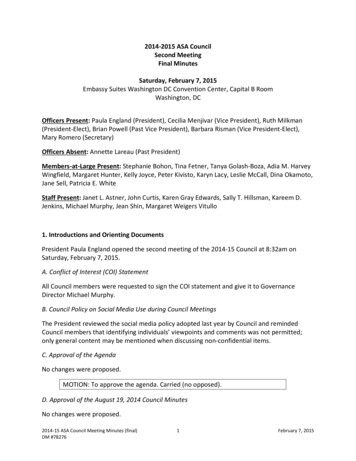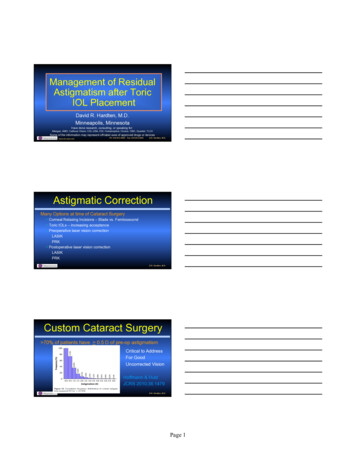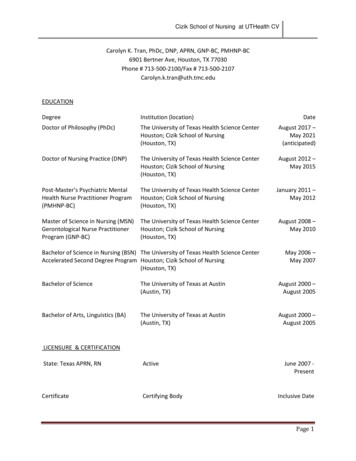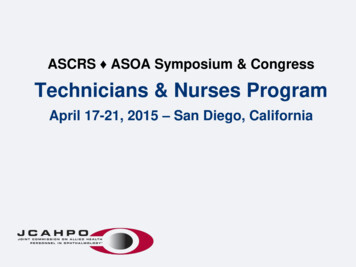
Transcription
ASCRS ASOA Symposium & CongressTechnicians & Nurses ProgramApril 17-21, 2015 – San Diego, California
Update onPost--RefractivePostSurgeryIOL CalculationsASCRS Technicians and Nurses ProgramApril 18th, 2015Rhonda G WaldronMMSc,, COMT, CRA, ROUB, CDOSMMScDiagnostic Echographer,Echographer, Senior Associate in OphthalmologyEmory Eye CenterAtlanta GAOwner, Eye Scan Consultingrhondawaldron@comcast.netThe PostPost--Refractive SurgeryKeratometry Challenge Different machines measure different areas ofthe cornea, producing different results Flattened or steepened K’s cause invalidassumptionspof ELP in our calculations formulasunless Double K modification used Using standard keratometry readings results inover--estimation of corneal curvature in theoverprevious myope due to reading a larger area thandesired, resulting in a hyperopic surprise(-3.0 D to 6.0 D) In the previous hyperope,hyperope, results in an underunderestimation due to reading a smaller area, and amyopic surpriseThe PostPost--Refractive SurgeryKeratometry Challenge Central cornea flattened for myopic correction,steepened for hyperopic correction Changes shape of cornea and refractive index ofstromatunlesslRK Standard formulas using anterior cornealmeasurements assume a predictable relationshipbetween front and back surfaces After LASIK, only the anterior surface isreshapedWarn the Patient! These patients are at a higher risk of animperfect result which could require yetanother procedure for desired targetrefraction, i.e. more refractive surgery, anIOL exchangeexchange, a piggyback lens Tell them to expect two procedures fromthe beginning?Clinical History MethodClinical History MethodKoch, et al AJO 1989; 108:676108:676--82Koch, et al AJO 1989; 108:676108:676--82 Previously considered “Gold Standard”,but now one of least favored methodsrecords, no sign of cataract at Requires recordstime of refractive surgery and postpost--op Need three numbers:1. PrePre-Op MR ((sphsph eq)eq)2. PrePre-Op K’s (average)3. PostPost--Op MR ((sphsph eq)eq) Determine how much correction tookplace, thenK PrePre-Op Avg. K – change in MR1
Clinical History MethodWhat If’sKoch, et al AJO 1989; 108:676108:676--82 What if patient had enhancements ormultiple types of procedures? The stable postpost--op refraction is thespherical equivalent after LASTPROCEDUREFor example: Average K prepre-LASIK 45.75 D - 5.00 D myope prepre--LASIK - 0.25 D myope postpost--LASIK Change in MR 4.75 D K 45.75 D - (4.75 D) 41.00 D-10-9-8-7-6- 5 -4-3-2-10123456789104.75What If’sClinical History MethodKoch, et al AJO 1989; 108:676108:676--82 What if the patient had refractivesurgery to correct hyperopia insteadof myopia? ADD the amount of correction fromoriginal K rather than subtract due tocorneal steepeningFor example: Average K prepre-Lasik 42.75 D 3.50 D hyperope prepre--Lasik - 0.25 D myope postpost--Lasik Change in MR 3.75 D K 42.75 D (3.75 D) 46.50 D-10-9-8-7-6- 5 -4-3-2-10123456789103.75The Most ReliableMethods TodayShammas PLFor Myopic LASIKShammas,, et al AJO 2003; 136:426Shammas136:426--32 Measure K’s postpost--op ( IOL Masteror Sim K preferred), average, thenK 1.14 (K postpost-op) - 6.8 In his study, 93.3% within 1D oftarget2
Wang--KochWangKoch-Maloney MethodShammas PHLFor Hyperopic LASIKWang, Booth, Koch. Ophthalmol 2004; 111(10):1825111(10):1825--1831Shammas,, et al J Cataract Ref Surg 2013; 39:739Shammas39:739--744For myopic LASIK patients: Obtain topography postpost--op, then Measure K’s postpost--op, average, andadjust with formula:K 1.114 (Ccp(Ccp)) – 6.1Kc 1.0457 (K(Kpostpost--op) – 1.9538Where Ccp is the central corneal power withcursor at the exact center of the Axial MapRecommend using Atlas topographerMasket MethodMasket MethodMasket S, Masket SE. JCRS 2006; 32:43032:430-434Masket S, Masket SE. JCRS 2006; 32:43032:430-434 Best performance in some recent studiesfor PRK and LASIK patients (not RK!) MustM tkknow amountt off correctiontiffromhistory (LSE spherical equivalent ofchange after laser vision correction)IOL Adjustment LSE x ((--.326) 0.101Masket Formula ExamplesPrior Myopia (use SRK/T ): Formula yields 16.0 D LSE -6.00 D -6.0 X ((--0.326) 0.101 2.057 16.0 2.0 18.0 D Final IOL Power Adjust final power, not measurementsUsed IOLM K’s and Biometry for studyMay use Sim K and immersion insteadNo need to determine corneal powerMean outcome -0.15 D, 28 out of 30 eyeswithin 0.5 D of targetMasket Formula ExamplesPrior Hyperopia (use Hoffer Q): Formula yields 22.0 D LSE 3.0 D 3.0 X ((--0.326) 0.101 - 0.877 22.0 – 1.0 21.0 D Final IOL Power3
Modified Masket MethodWarren Hill’s data produced a slightlydifferent regression formula whenworking to validate the Masket Method:IOL Adjustment LSE x ((--0.4385) 0.0295Modified Masket MethodCalculated IOL power 15.26 DStable SE correction after LASIK -5.0 DMasket Method:(-5.0 X -0.326) 0.101 1.73 D, so 15.26 D 1.73 D 16.99 DModified Masket Method:(-5.0 X -0.4385) 0.0295 2.22 D, so 15.26 D 2.22 D 17.48 DHaigis L For both myopic and hyperopicLASIK on recent versions of IOLMaster Older versions have neither SemiSemi--older versions have myopiconly Use IOLM or immersion biometry,but IOLM K’s only!Aramberri Double KAramberri. JCRS 2003; 29(11):2063Aramberri29(11):2063--2068 Formulas actually use K’s twice:once regarding amount of power ofcornea to bend light, the other tohelp predict ELP With doubledouble--K modification, an avgK is inserted into the formula whereELP is predicted, adjusted K wherecorneal power is used Axis II and Sonomed have double KHaigis L For myopia, Haigis L has acorrection function for IOL Masterkeratometry plus a correctionfactor for the ACD change (0.5mm steeper since part of cornearemoved) due to ablation – nohistory required For hyperopiahyperopia,, since no ablation,has correction function for K’sonlyHolladay II Double K Correction Check the box in Holladay II for“Prev RK, PRK, LASIK” and itautomaticallyypputs avgg K ((43.9 Dunless you provide historicalinformation, then will use that) inELP prediction4
ASCRSPost--Refractive SurgeryPostIOL CalculatorPrior Myopic LASIK/PRKwww.ASCRS.org(link on home page)Prior Myopic LASIK/PRKPrevious Calculator VersionPrior Myopic LASIK/PRKPrevious Calculator Version Research showed repeatedly that methods in second and thirdcolumns perform better than those of the first column Calculator had average of 2nd and 3rd columns only aboveaverage from entire calculatorPrior Myopic LASIK/PRKPrevious Calculator Version Typically first column much stronger thansecond and thirdPrior Myopic LASIK/PRKNew Version Best results from MasketMasket,, Shammas,Shammas, HaigisHaigis-L,and WangWang-KochKoch--Maloney, PotvinPotvin-Hill, Barrett Completely eliminated first column!5
Potvin--Hill Pentacam MethodPotvinPotvin--Hill Pentacam MethodPotvinPotvin,, R and Hill, W. J Cat Refract Surg 2015: 41:339Potvin41:339--347Potvin,, R and Hill, W. J Cat Refract Surg 2015: 41:339Potvin41:339--347 For myopic LASIK only Directly determines the corneal power bymeasuring both the anterior and posteriorsurfacesfwithith theth PentacamP trotatingt tiScheimpflug camera Best results were found to be from using thetrue net power measurements in the 4.0 mmzone centered on the corneal apex(TNP Apex Zone 40), used in ShammasformulaPotvin--Hill Pentacam MethodPotvinPotvin,, R and Hill, W. J Cat Refract Surg 2015: 41:339Potvin41:339--347 Results compared to other methods onASCRS website Produced calcs similar to those obtained fromexisting formulas on the ASCRS websiteBarrett True K MethodBarrett GD. TrueTrue-K formula: New Approach to biometryafter LASIK. Presented at ASCRS 2009 For myopic LASIK, hyperopic LASIK, and RK Based on Barrett Universal II formula Calculates a modified K value for postpostrefractive patients Requires optical Ks as measured and the prepreand postpost--refractive surgery refractions formaximum accuracy Can also be run when no history availableBarrett True K MethodOCT--Based MethodOCTBarrett GD. TrueTrue-K formula: New Approach to biometryafter LASIK. Presented at ASCRS 2009Huang D et al. Transactions of the AmericanOphthalmological Society, 2013: 111:57111:57-68 For myopic LASIK, hyperopic LASIK, and RK Net corneal power, posterior corneal power,and central corneal thickness are obtainedfrom RTVue or RTVueRTVue-XR ((OptovueOptovue Inc) Axial length and ACD from IOL Master Recommended to perform three OCT scansand use the median net and posterior cornealpower6
Prior Hyperopic LASIK/PRKPrior Hyperopic LASIK/PRKPrior RKPrior RKRK Patients History method not as good forpost--RK due to unstable postpostpost--oprefraction Measure them in morning ratherthan afternoon – K’s flatter in theam, steeper in pm Make them plano in the am, myopicin pm – not hyperopic am, planopm!RK Patients Aim for -0.75 or -1.00 in postpost--RKpatients because of hyperopic shift overseveral years Don’tD ’t wantt themthtot driftd ift intoi t hyperopiahi drift into plano instead After RK, many patients have ahyperopic surprise that will settle outover time Do NOT do IOL exchange until after 2stable refractions on 2 different visits atleast 2 months out!7
Disadvantages of ASCRSCalculator No power ranges from which to choose Can only run for one IOL on the page,so must run multiple times for differentIOLsEmory Protocol forPost--Refractive PatientsPost Now docs have all four lenses calculatedon the page Now they have power ranges from whichto choose Holladay II may differ a little from ASCRScalculator of same method becausemore of the eye anatomy beingconsidered than Holladay I formulabeing used in calculatorEmory Protocol forMyopic LASIK PatientsFor Holladay II: Manually calculate Ks by Shammas PL IOLM KK’s:s: 40.66/41.2640 66/41 26 Average those Ks (add them together,then divide by 2) Avg K 40.96 Shammas PL 1.14 (40.96) – 6.8 Adj K for calcs 39.89Emory Protocol forPost-Refractive PatientsPost Run ASCRS Calculator, but also: Adjust K’s with Shammas Methodmanually and enter into Holladay IIformula as “Surgeon enteredadjusted K” Check box that patient had priorrefractive surgery so it functions as adouble K formula!Emory Protocol forMyopic LASIK Patients AEL: 26.46 OD by immersion IOLM K’s: 40.66/41.26 OD Targeted plano ODEmory Protocol forMyopic LASIK Patients Adjusted K of 39.89 entered into H II Checked box that patient had priorrefractive surgery IOL Power 17.50 D PostPost--Op outcome:-0.75 0.50 x 176 20/208
Emory Protocol forHyperopic LASIK Patients AEL: 22.26 OS by optical IOLM K’s: 46.18/47.02 OS Targeted plano OSEmory Protocol forHyperopic LASIK Patients Adjusted K of 46.77 entered into H II Checked box that patient had priorrefractive surgery IOL Power 20.0 D PostPost--Op outcome:plano 20/20Emory Protocol forRK Patients AEL: 22.99 OD, 22.79 OS IOLM K’s: 43.55/44.35 OD44.41/44.8844 41/44 88 OS Target -0.75 OUODOSEmory Protocol forHyperopic LASIK PatientsFor Holladay II: Manually calculate K’s with Shammas PHL IOLM KK’s:s: 46.18/47.02 Average those Ks (add them together,then divide by 2) Avg K 46.60 Shammas PHL 1.0457 (46.60) – 1.9538 Adj K for calcs 46.77Emory Protocol forRK Patients Run ASCRS Calculator, but also: Just use average optical K from IOLM orLS (which( hi h formulafl doesdautomatically)tti ll ) Check box that patient had priorrefractive surgeryEmory Protocol forRK PatientsFor Holladay II: Enter as normal so program will average IOLM K’s OD: 43.55/44.35 (avg(avg 43.95) IOLM K’s OS: 44.41/44.88 (avg(avg 44.65) Check box that patient had prior refr sx IOL Power 22.5 D OU PostPost--Op outcome:OD: -1.00 1.00 x 175 20/20OS: -0.50 20/1520/15--19
Patient Unsure Patient had LASIK OU, wasn’t sure what type Asked if she was nearsighted or farsighted beforehand Her answer was “both”TopographyMyopic LASIK Flat zone centrallyCAUTION!!! ALL methods require good data in! If measurements are not accurate,none of the methods work! Must use ultrasound for long eyes!Patient Unsure Patient had LASIK OS only for monovision purposes Was plano OU beforehand Would that be myopic or hyperopic LASIK?TopographyHyperopic LASIK Steep zone centrallyWe must first get the correctaxial length! Eyes 25.0 mm or longer:Optical tends to measurelong eyes too long –hyperopic surprisesreported - do immersionand BB-scan biometry toverify10
Long Eye:Optical vs. Ultrasound28.51 mm28.37 mm28.10 mmOptimizing Axial Length in Long EyesWang, et al, J Cataract Refract Surg 2011; 37:201837:2018--202728.09mmPost-op using Imm:PostImm:OD: -0.75 1.25 X 140 (SE -0.125)OS: -0.50 0.50 X 008 (SE -0.25)Optimizing Axial Length in Long Eyes The problem with using an optimizationequation is that sometimes optical gets itright! AdjustingAdj ti a measurementt thatth t didn’tdid ’tneed adjusting will still lead to a postpost--opsurprise The best way to measure the high myopeis with ultrasound so you know it iscorrectWhy High Myopes areHarder to Measure Holladay I formula:0.8814 x AL(IOLM) 2.8701 Adjusted AL Haigis formula:0.9621 x AL(IOLM) 0.6763 Adjusted AL SRK/T formula:0.8981 x AL(IOLM) 2.5637 Adjusted AL Hoffer Q formula:0.8776 x AL(IOLM) 2.9269 Adjusted ALImmersion Technique Probe immersed inshell of saline Most accurate/nocorneal compression(0.015 - 0.05 mmdepending onmanufacturer) The method to whichoptical wascalibrated in itsdevelopmentWhy High Myopes areHarder to Measure The eye is misshapen, oval or elongatedrather than round Macula on a “slope” Perpendicularity impossible11
Posterior StaphylomaB-Biometry Technique Align BB-scan with “HMAC”position (probe on cornealvertex, marker nasal) with 4or 5 mm of gel on probe tip Corneal vertex andposterior lens surfacepcentered on left, maculacentered on right inferior tooptic nerve Macula 4.5 mm down fromcenter of optic disc Place one caliper on frontof cornea, move the otherthrough the center of thelens to macular surface Uvea bulging into thin,stretched sclera Commonly in posteriorpole Perpendicularityimpossible Measurements varygreatlyIf you don’t see the cornea,you aren’t using enough gel!B-Biometry TechniqueComparison to Good Immersion23.78 on AA--scan23.80 on BB--scanConclusionB-biometry 30.34mmA-scan 30.03,30.26, 30.0, 30.20,30.15, 29.98 Records will continue to be difficult to obtain,research emphasis being placed on methodsthat don’t require history Keep up with the latest methods Use ASCRS calculator Know which methods are most reliable Don’t forget to get ultrasound measurementson the long eyes! Do NOT measure the cornea after an eyeexam! ALL methods require good data in!12
after LASIK. Presented at ASCRS 2009 For myopic LASIK, hyperopic LASIK, and RK Based on Barrett Universal II formula Calculates a modified K value for postCalculates a modified K value for post-re
